Chile's house prices up, sales down
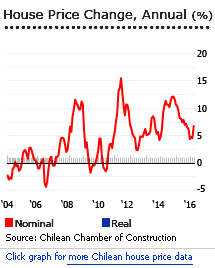 The increase in Santiago's property prices continues unabated. In Greater Santiago, the average "real" price of new apartments rose by 6.8% during the year to March 2016, according to the Chilean Chamber of Construction (CChC).
The increase in Santiago's property prices continues unabated. In Greater Santiago, the average "real" price of new apartments rose by 6.8% during the year to March 2016, according to the Chilean Chamber of Construction (CChC).
New apartments in Southern Santiago saw the highest price rises, with a 12.7% increase y-o-y to March 2016. Western and Eastern Santiago saw price increases of new apartments around 6.8% and 5.8%, respectively. However new apartment prices in Central Santiago actually fell by 1% in real terms during the year to March 2016.
Home sales in Greater Santiago fell by 41% to 5,015 units during the year to Q1 2016, according to CChC figures. That's because home buyers rushed to buy before the end of 2015 to avoid paying higher prices in 2016 due to the implementation of VAT on properties.
"Many people that would have bought their home this year decided to do it last year so as not to pay the home tax that came about with the tax reform, so the fall in home sales was a predictable phenomenon," according to CChC sub director of research Marcela Ruiz-Tagle.
Chile’s real estate market saw real house prices increasing by almost 70% from 2004 to 2015. Even during the global financial crisis of 2009, there was only a small average price decline of 0.7% (from May to September 2009). The 2010 Chile earthquake of February 27, 2010 also limited annual house price growth that year. In 2011, house prices bounced back with 9.5% growth, followed by 5.5% growth in 2012, 4.2% in 2013, and 11.7% in 2014. The sudden rise was mainly driven by the apartment market, as strong demand accumulated in the northwest and southern areas of Greater Santiago from the beginning of 2014. Despite this in 2014, uncertainty around the new government, and its announcement of a possible tax adjustment, slowed sales. Also, supply shortages continued in 2014, especially in Greater Santiago due to land shortages, despite an increase in building permits, according to CChC.
In 2015, house price rises in Greater Santiago slowed to 4.4%, although national home sales accelerated by 24.6% to 79,694 units, along with a slight improvement in the country's economic condition. Increased building starts in 2014 and 2015 matched the increased demand, which helped to slow price rises.
In 2016, VAT of 19% will be imposed on sales of properties by "habitual sellers" such as real estate companies, and to legal or natural persons who purchase and sell their properties in a span of less than one year. Raw land or unimproved building lots are exempt from VAT.
According to the CChC, the VAT imposition is expected to increase property prices by around 8% to 12%, with properties worth CLF 1,000 (US$ 38,224) to CLF 3,000 (US$ 114,671).
Any individual or corporate body can acquire and own real estate in Chile, whether or not they are residents. However there are some restrictions regarding land located near the boundaries of the country. Chile has strong legal protection of property rights.
Housing reconstruction efforts continue
Chile was struck by an 8.8 magnitude earthquake on February 27 2010, and a tsunami. The earthquake, the sixth largest ever recorded, affected six regions of central and southern Chile inhabited by around 12 million people or around 75% of Chile’s population.
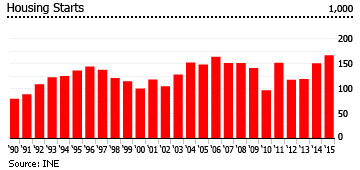
The government implemented a national reconstruction plan, aiming for full recovery by March 2014, requiring around US$2.5 billion worth of subsidies, and committed to rebuilding 220,000 homes. The reconstruction program also addressed the rebuilding of homes destroyed and damaged during the Valparaiso fire and the earthquake in northern Chile in April 2014.
As of April 2016, the housing ministry (Ministerio de Vivienda y Urbanismo de Chile or MINVU) reportedly had allocated a total of 240,658 subsidies related to housing reconstruction. Some were foregone, but 220,473 were spent, 4,482 are still underway, while 449 have yet to begin.
In 2010, construction starts were sharply down, due to changes in construction rules after the earthquake. Activity recovered in 2011 with 151,071 housing starts. In 2012, housing starts fell by 22.4% y-o-y to 117,310 units, followed by a meagre growth of 1.3% to 118,796 units in 2013. Housing starts surged in 2014, increasing by 26.7% to 150,453 units. In 2015, housing starts increased by 10.5% to 166,170 units, up on the previous 2006 peak of 163,236 housing starts.
Chile’s unique diversity
Chile is a country like no other in Latin America. It stretches for more than 4,000 kilometres, making it the longest country in the world, with the Pacific Ocean on one side and the Andes on the other.
Because of this, Chile has a very diverse terrain and ecosystem. The Atacama Desert in the north is the driest in the whole world. On the other hand, the South is filled with thick forests and a succession of volcanoes and lakes.
The population is concentrated in the centre region, also known as the Central Valley, where the capital Santiago is also located. Densely-populated Santiago is home to about 30% of Chileans. It is also visited by the most number of both local and foreign tourists.
Successful housing program
Chile may seem to have enough land to house its 17 million people, but most arable land is concentrated in the Central Valley.
A housing shortage still exists in Chile, but has been reduced significantly through a very successful housing policy. The Ministry of Housing and Planning (Ministerio de Vivienda y Urbanismo or MINVU) was created in the 1970s, and it has dominated the housing sector since. It is the country’s largest real estate firm, and its second largest mortgage bank.
The special law Decreto con Fuerza de Ley 2 (DFL-2) encouraged affordable housing of less than 140 square metres (sq. m). DFL-2 properties are exempt from income tax, and enjoy 50% off the Real Estate Tax for corresponding periods, according to land area.
Mortgage market continues to rise
Chile’s mortgage market is one of the most developed in Latin America. It has grown steadily from 11.1% of GDP in 2001 to 23.2% of GDP in 2015. Most mortgages are fixed rate with maximum LTV ratios of around 75% to 80%, which helps contain the banking system’s credit risk.
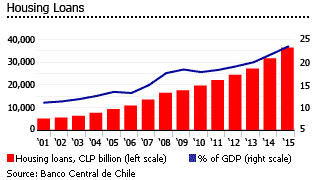
Chile’s banks do not usually lend to foreigners, even to those with a resident’s permit. Banks have strict lending criteria which are almost impossible for foreigners to satisfy. These tight controls on mortgage lending may have reduced the country’s exposure to the global financial crisis.
The average rate on housing loans was relatively stable from 2006 to 2008 at around 5% and then floated at around 4% from 2009 to first half of 2014. Since the second half of 2014, the average housing loan rate has been around 3%. In April 2016, the average lending rate was at 3.79%.
The Central Bank of Chile lowered its benchmark interest rate in response to Chile’s economic recession to 0.5% from July 2009 to May 2010. The central bank then made twelve consecutive rate hikes to 5.25% in June 2011. Due to slower economic growth and the euro zone crisis, the benchmark rate was reduced to 5% in January 2012. In October 2013 the central bank lowered the rate by 25 basis points to 4.75%, which was followed by 7 more rate cuts within a year, so that the rate declined to 3% in October 2014.
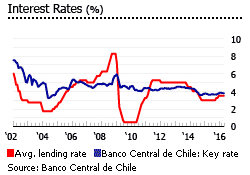
A year after (October 2015), the benchmark interest rate was raised by 25 basis points to 3.25%, as inflation significantly surpassed the target at 4.6% in September 2015. Another rate hike was implemented in December 2015, lifting the rate to 3.5%.
Inflation in the next two years is expected to be within the 3% target, although the central bank expects inflation of above 4% for the coming months. The central bank stated that "to ensure the convergence of inflation to the target, monetary policy will need to continue to normalize, at a pace that will depend on incoming information and its implications on inflation projections".
Moderate yields
Chile has a small but competitive rental market. Currently, gross rental yields in Santiago and Viña del Mar are moderate, based on Global Property Guide research in November 2015. Apartment rental yields in Santiago city range from 4.26% to 5.20%.
Rental yields in Viña del Mar were lower than in Santiago, ranging from 3.89% to 4.95%. The lower yields may be due to the stronger demand for ownership in coastal cities compared to the capital.
Economic expansion in 2016, but expect weak performances in some sectors
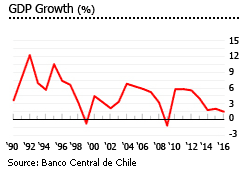
The Chilean economy suffered from unfavourable external conditions and weak investment in 2015, but it still did slightly better than in 2014.
In 2015, Chile's GDP rose by 2.1%, after 1.9% in 2014. Chile's economic expansion in 2015 was driven by domestic demand, with government consumption rising by 5.8% and household consumption by 1.5%. Investment, on the other hand, remained weak.
Chile started 2016 with an expansion of 2% during the year to Q1 2016. The economy was aided by the price increase of copper (Chile's main export commodity) and other commodities. This led to the 2.4% y-o-y rise in exports, the fastest growth in two years. Imports, on the other hand, contracted further by 3% (from -1.9% in Q4 2014).
The central bank predicts an economic expansion of 1.25% to 2% in 2016, a downgrade from an earlier forecast of 1.25% to 2.25%. In 2017, economic growth is expected to be around 2% to 3%. "We expect the economy to continue growing below its potential for a few more quarters, impacted in particular by the weak performance of those sectors most dependent on investment," said the central bank in its recent quarterly Monetary Policy Report.
Chile ranks as an upper-middle income economy according to the World Bank. It has a track record of sustained growth, having grown at an annual average of 5.6% from 1990 to 2007, among the highest growth rates in the world.
From 2008 to 2012, Chile’s economy continued to grow strongly, and only had an economic contraction of 1.1% in 2009 as a spillover effect of the global financial crisis. Chile then managed a rebound of 5.7% growth in 2010, despite the earthquake. Strong economic growth continued from 2011 to 2013, with an average growth rate of 5.1%. In 2014, Chile posted its slowest economic growth since 2009, expanding by only 1.9%, due to the decline in global demand for copper and other mining products, and slower than expected output and domestic demand.
In May 2010, Chile became OECD´s first Southern American member, highlighting reduction of poverty from 45% in the late 1980s to around 14% in 2009. There were other advances, such as strengthening of state institutions and fighting corruption.
Fiscal discipline is one of the pillars of Chile’s solid international image. From 2000 to 2012, Chile recorded an average budget surplus of 1.7%, reaching a record high of 8.8% of GDP in 2007. The budget surplus not only transformed Chile from a debtor to a creditor country, but also placed the country in solid position to weather global economic volatility.
During the 2009 recession, the Chilean government increased spending by 16%, availing of funds specially set aside from sales of copper profits. A fiscal stimulus program worth around 2.4% of GDP was implemented, which led to a fiscal deficit of around 4.5% of GDP by the end of 2009. The deficit narrowed to 0.02% of GDP in 2010 as the economy recovered. Chile posted a fiscal surplus of 1.87% of GDP in 2011 due to rising copper prices and higher tax revenues, followed by a surplus of 1% of GDP 2012. However, the country recorded three consecutive years of fiscal deficits: 0.7% in 2013, 1.6% in 2014, and 2.2% in 2015, due to the decline of income from Chile's main export commodity, copper.
One of Chile’s perennial problems is high unemployment, mainly due to restrictive and complicated labour laws, and relatively generous social benefits. Unemployment rose to around 8% to 10% during 1999, but fell back to around 7% in 2006. The recent economic recession triggered another increase in unemployment to around 10% in 2009. However unemployment is currently subdued at 6.4% as of February-April 2016. According to the central bank, the jobless rate may rise up to over 7% in 2016 due to falling investment and weak economic growth. "The coming quarters are going to see lower (growth) on average ... so it's difficult to think that there could be an improvement in the labor market during the remainder of the year," said Rodrigo Vergara, Central Bank of Chile President.
In 2014, Chile began a new presidency. The Socialist Party's Michelle Bachelet had already served as president from 2006 to 2010 (Chile has a one-term presidency limit), and won in the run-off election held on December 15, 2013 against labour minister Evelyn Matthei, with 62.3% of the total votes. The new president, who succeeded the position previously held by former president Sebastián Piñera in March 2014, vowed to push educational, constitutional, and tax reforms during her term.